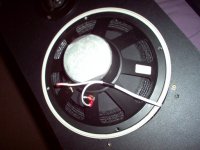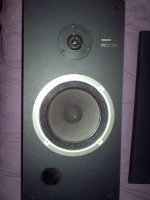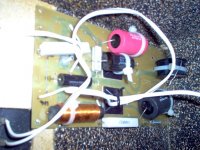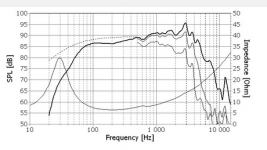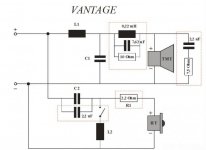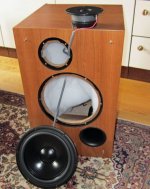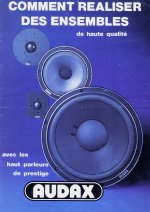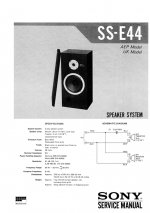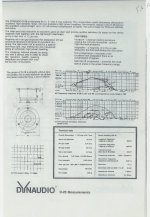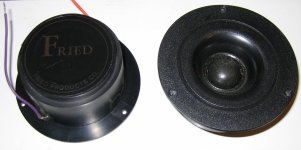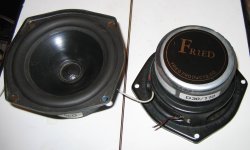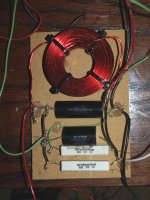
Yup, I'm impressed Ro808! That seems to be exactly what I have in my Sony E44!
Mine says: Sony 200W 033, T-8110-137-1, IMP 8R 65W (Max), Made in France.
I guessed it was a well-behaved woofer, or you'd never get away with no bass filter and a 3.3uF on the tweeter. It's actually quite like a SEAS CA22RNX. The last image, but a low loss cardboard former, I'd guess.
But I think I have improved it. Only Mylar tweeters seem to work well with this one. The crossover now is below. I have currently fitted a Visaton DT94-8 tweeter with a third order tweeter filter and a Zobel on negative polarity, as is my wont. The bass filter is around 0.7mH and 8.2R plus 8.2uF shunt. I just tuned it by ear, with the help of Visaton Boxsim to get the tweeter right.
It's an excellent retro bass, IMO. Cloth surround and almost non-existent dustcap. Great detail. They really should make 'em like this now.
Attachments
Member
Joined 2009
Paid Member
no bass filter, with that spoke at 4kHz - ugh
Yup, it did sound kinda ropey on the original non-existent crossover. Joachim Gerhard applied a 3-4kHz notch on the inevitable peak with his CA22RNX design. I applied some simple impedance correction and rolloff. Many ways to skin a cat!
Attachments
Member
Joined 2009
Paid Member
Or, perhaps one of these? 
Attachments
-
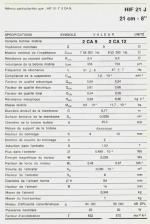 Audax HIF 21 J_Sony E-44_2.png743.5 KB · Views: 121
Audax HIF 21 J_Sony E-44_2.png743.5 KB · Views: 121 -
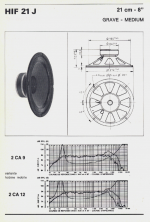 Audax HIF 21 J_Sony E-44_1.png781.4 KB · Views: 125
Audax HIF 21 J_Sony E-44_1.png781.4 KB · Views: 125 -
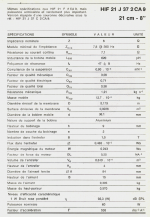 Audax HIF 21 J 37 2 CA 9_Sony E-44_2.png394.1 KB · Views: 130
Audax HIF 21 J 37 2 CA 9_Sony E-44_2.png394.1 KB · Views: 130 -
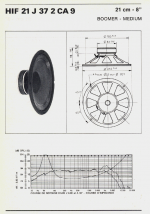 Audax HIF 21 J 37 2 CA 9_Sony E-44_1.png430.2 KB · Views: 141
Audax HIF 21 J 37 2 CA 9_Sony E-44_1.png430.2 KB · Views: 141 -
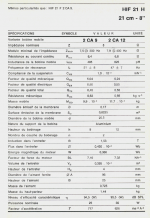 Audax HIF 21 H_Sony E-44_2.png372.2 KB · Views: 140
Audax HIF 21 H_Sony E-44_2.png372.2 KB · Views: 140 -
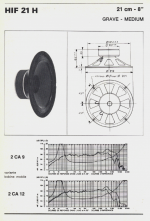 Audax HIF 21 H_Sony E-44_1.png781 KB · Views: 196
Audax HIF 21 H_Sony E-44_1.png781 KB · Views: 196 -
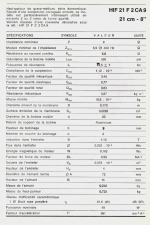 Audax HIF 21 F_Sony E-44_2.png405.9 KB · Views: 158
Audax HIF 21 F_Sony E-44_2.png405.9 KB · Views: 158 -
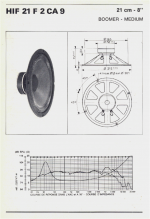 Audax HIF 21 F_Sony E-44_1.png783.6 KB · Views: 327
Audax HIF 21 F_Sony E-44_1.png783.6 KB · Views: 327
And that's not all...
These were taken from one of the many catalogues of Audax, under the category "series professionnelle et industrielle".
In the 1970's and 1980's this renowned manufacturer was one of the major OEM suppliers in Europe, until Harman Group took over...
The mid driver on the attached image, is the famous paper cone which was used by EAW, EV, Nexo and Westlake.
These were taken from one of the many catalogues of Audax, under the category "series professionnelle et industrielle".
In the 1970's and 1980's this renowned manufacturer was one of the major OEM suppliers in Europe, until Harman Group took over...
The mid driver on the attached image, is the famous paper cone which was used by EAW, EV, Nexo and Westlake.
Attachments
Last edited:
But I think I have improved it. Only Mylar tweeters seem to work well with this one. The crossover now is below. I have currently fitted a Visaton DT94-8 tweeter with a third order tweeter filter and a Zobel on negative polarity, as is my wont. The bass filter is around 0.7mH and 8.2R plus 8.2uF shunt. I just tuned it by ear, with the help of Visaton Boxsim to get the tweeter right.
It's an excellent retro bass, IMO. Cloth surround and almost non-existent dustcap. Great detail. They really should make 'em like this now.
Nice work, Steve!
Crossover is around 3KHz?
Attachments
Last edited:
The first one is closest. I measured 71 X 15mm magnet. 25mm voicecoil. 4mm magnet gap.
Inductance must be around 1mH for impedance correction purposes. 20 ohms at 10kHz. Aluminium former! That surprised me. But I can see it is shiny through the thin cloth dustcap. Qms is 3.4.
I just checked the filter I settled on: 0.7mH, 8.2R + 8uF shunt on bass.
4.7R, 4.7uF/ 0.2mH / 6.8uF and a 7.5R/ 1.5uF Zobel all in negative polarity. Somewhere around 3kHz crossover.
Have to go now, but will look in later.
Inductance must be around 1mH for impedance correction purposes. 20 ohms at 10kHz. Aluminium former! That surprised me. But I can see it is shiny through the thin cloth dustcap. Qms is 3.4.
I just checked the filter I settled on: 0.7mH, 8.2R + 8uF shunt on bass.
4.7R, 4.7uF/ 0.2mH / 6.8uF and a 7.5R/ 1.5uF Zobel all in negative polarity. Somewhere around 3kHz crossover.
Have to go now, but will look in later.
Last edited:
An externally hosted image should be here but it was not working when we last tested it.
The above kit speakers look anything but dated.
Not bad, considering these were designed in 1977.
My post on Irving "Bud" Fried and IMF was intended as an introduction to this man's background. After he left IMF, Bud started working on small projects including a series of DIY loudspeaker kits for Sonikit, a speaker kit outfit from the late 70s run by Dennis Jaeger. This is were it gets interesting, because these kits seem to be quite sophisticated designs, with a sensible choice in drivers.
A Quote from Dennis Jaeger (Source: Audiokarma):
"Sonikit was founded to offer high end speaker kits, many of these were European designs. I contacted Roger West (Soundlab Electrostatics) and he persuaded the then current owners of Janszen Electrostatis to let me market their speakers in kit form. I contacted Bud Fried and persuaded him to offer some of his speakers in kit form. Unfortunately it did not occur to me to get an exclusive from him and he started selling the kits through his regular network also... I am sure this cut into my sales and also undercut my national advertising budget. I also landed the west coast SEAS distributorship and marketed kits from them as well as Rectilinear. I also offered a couple of amateur Brit TL designs as well as one of the Radford designs (where Bud learned about TLs) .
I entered the picture just as Bud was switching to Dalesford from KEF drivers. I had also gotten US distributorship for the Dalesford drivers. As was common for Bud, he would request modifications to a manufacturers drivers and then claim them as his own (not an unusual practice in the industry), while they would offer them in their catalog. Bud did this with Dalesford, most notably with the 10" driver he used in his "H" subwoofer systems, and in his "line tunnel" designs.
Contrary to the practice of those in Britain who taught him, Bud was very secretive about all aspects of his designs. His relationships with his British peers was strained to say the least.
When Fried initially moved to Britain his first association (I think he worked there, but not sure) but it was directly from Arthur Radford that he learned about designing TLs (Radford had the "first" commercial designs on the market, and very interesting ones at that). He fairly early on set up a marketing outfit and encountered Wright and started marketing Wright and his partners designs - I'm not sure if IMF (marketing) was founded before or after he became involved with Wright etc. Eventually there was a law suit in Britain between Wright and partner and Fried over the use of the IMF name and product lineage and Fried lost. He then started marketing his designs in the States under "I.M. Fried Products". Everyone... Radford, Wright, Fried and others "learned" about TL's from Bailey's work. Actually the design principles date back to the Thirties. There was "bad blood" between Radford and Fried.
BTW: Sonikit failed because I simply bit off too much too soon. Too many design lines, too much overhead, too big an advertising budget, etc. Big time beginners mistakes. I'm still rather happy with the lines I rounded up, with the exception of Rectilinear.
I had Wilmslow Audio in mind when I got the idea to set up Sonikit. Looking back, I think the wiser course would have been to place the main stress in Fried and SEAS and to offer the kits pre-mounted on baffles, like the KEF Kits, and let the customer do the work on the rest of the enclosure. Perhaps offer a couple complete Fried kits.
Mr. Fried was a lawyer operating in a world of engineers. He was quite good with words, at public relations and creating an image. He was also a extremely bright engineer. He was famous for saying "Don't tell me what others are doing, I do what I think is right". In actuality, he was constantly pumping me for my opinions and information on what others were doing.
He could walk into a room and look at the setup, judge the distance of the speakers from the boundaries and give you an estimate of the set-ups resonance problems."
Last edited:
Some extra info on the (Soni)kit models (from mpbarneyspeakers):
The sloped front baffle time aligned pyramid shaped enclosures in the model C satellites predate many that have copied it was first used in 1978 IIRC.
Fried often wrote and discussed how important phase, amplitude and magnitude are in a speaker design.
He was also one of the first to use polypropylene cones and double stacked magnet structures in his TOTL speakers.
"The Fried B/2 is a mini-monitor speaker, marketed in the late 1970s, starting in 1978. It competed in a market segment that included the Rogers LS3/5a, JR 149 and KEF 101, among others (shown in the last image below). It was sold both stand-alone, as the Model B/2, and with a separate dual channel, single box, transmission line subwoofer called the Model T. As a package, the three piece satellite-subwoofer combination was called the Model H/2, shown below. It was sold both in assembled and kit form. One dealer (Sonikit)'s prices in 1979 for the B/2 were $600/pair assembled, $420/pair for the kit version including cabinet kits."
The Fried Model H speaker system was sold in the 1978 timeframe as both a kit and assembled system. Designed by Irving "Bud" Fried, it was the first satellite-subwoofer system. The satellites consisted of a KEF T27 tweeter and B110 bextrene cone midrange (the same drivers used in the LS3/5a speaker of the same vintage) in a sealed cabinet. The woofer consisted of a single cabinet housing two separate transmission lines driven by a KEF B200 SP1022 bextrene cone woofer as both a kit and assembled system. There was no crossover in any of the cabinets, instead, all crossover components were housed in an aluminium chassis seen atop the woofer in the photo below.
The original B model used the KEF drivers. Also the T, O and Super Monitor subwoofers used OEM Dalesford subwoofers.
These models used a first order parallel crossover, while he was experimenting on series crossover circuits that were later used with the C2 satellites and O2 subwoofers.
Fried started having his drivers sourced for the B-2 and C satellites around 1977. The B-2 used a 6.5" OEM Dalesford bextrene cone driver made up until 1981, with the Dynaudio D-28H tweeter.
The second version used Scan Speak 2008 tweeters. The poly cones used in the C2 satellites and O2 subwoofer models were made by Transparent Sound which also went out of business.
What Fried produced were full range, efficient, first order/serial crossovers, wide band main driver, transmission line loaded, very coherent and dynamic loudspeaker systems.
Note:
The last image below shows the Fried Model B/2 along with some of its contemporary competitors. Left to Right: Fried B/2, Fried Model B (the B/2's predecessor, also used as satellite for the Model H), Rogers LS3/5a, and JR149. Note that except for the B/2, all of these speakers used the KEF T27 tweeter and KEF B110 mid-woofer.
The sloped front baffle time aligned pyramid shaped enclosures in the model C satellites predate many that have copied it was first used in 1978 IIRC.
Fried often wrote and discussed how important phase, amplitude and magnitude are in a speaker design.
He was also one of the first to use polypropylene cones and double stacked magnet structures in his TOTL speakers.
"The Fried B/2 is a mini-monitor speaker, marketed in the late 1970s, starting in 1978. It competed in a market segment that included the Rogers LS3/5a, JR 149 and KEF 101, among others (shown in the last image below). It was sold both stand-alone, as the Model B/2, and with a separate dual channel, single box, transmission line subwoofer called the Model T. As a package, the three piece satellite-subwoofer combination was called the Model H/2, shown below. It was sold both in assembled and kit form. One dealer (Sonikit)'s prices in 1979 for the B/2 were $600/pair assembled, $420/pair for the kit version including cabinet kits."
The Fried Model H speaker system was sold in the 1978 timeframe as both a kit and assembled system. Designed by Irving "Bud" Fried, it was the first satellite-subwoofer system. The satellites consisted of a KEF T27 tweeter and B110 bextrene cone midrange (the same drivers used in the LS3/5a speaker of the same vintage) in a sealed cabinet. The woofer consisted of a single cabinet housing two separate transmission lines driven by a KEF B200 SP1022 bextrene cone woofer as both a kit and assembled system. There was no crossover in any of the cabinets, instead, all crossover components were housed in an aluminium chassis seen atop the woofer in the photo below.
The original B model used the KEF drivers. Also the T, O and Super Monitor subwoofers used OEM Dalesford subwoofers.
These models used a first order parallel crossover, while he was experimenting on series crossover circuits that were later used with the C2 satellites and O2 subwoofers.
Fried started having his drivers sourced for the B-2 and C satellites around 1977. The B-2 used a 6.5" OEM Dalesford bextrene cone driver made up until 1981, with the Dynaudio D-28H tweeter.
The second version used Scan Speak 2008 tweeters. The poly cones used in the C2 satellites and O2 subwoofer models were made by Transparent Sound which also went out of business.
What Fried produced were full range, efficient, first order/serial crossovers, wide band main driver, transmission line loaded, very coherent and dynamic loudspeaker systems.
Note:
The last image below shows the Fried Model B/2 along with some of its contemporary competitors. Left to Right: Fried B/2, Fried Model B (the B/2's predecessor, also used as satellite for the Model H), Rogers LS3/5a, and JR149. Note that except for the B/2, all of these speakers used the KEF T27 tweeter and KEF B110 mid-woofer.
Attachments
-
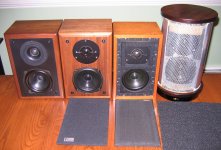 FriedB2competition.jpg582.4 KB · Views: 744
FriedB2competition.jpg582.4 KB · Views: 744 -
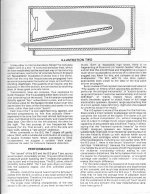 FriedH2brochure-page3.jpg314.6 KB · Views: 207
FriedH2brochure-page3.jpg314.6 KB · Views: 207 -
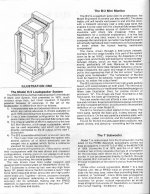 FriedH2brochure-page2.jpg320.4 KB · Views: 196
FriedH2brochure-page2.jpg320.4 KB · Views: 196 -
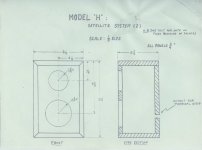 FriedB2cabinetplans.jpg107.5 KB · Views: 187
FriedB2cabinetplans.jpg107.5 KB · Views: 187 -
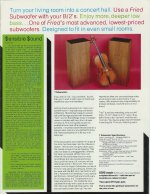 FriedB2Sonikitbrochure-page2.jpg372.4 KB · Views: 195
FriedB2Sonikitbrochure-page2.jpg372.4 KB · Views: 195 -
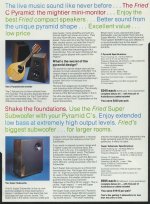 Fried C Pyramid & Super Subwoofer.jpg169.9 KB · Views: 756
Fried C Pyramid & Super Subwoofer.jpg169.9 KB · Views: 756 -
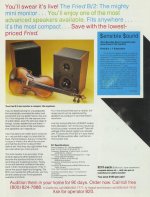 Fried B2 Mini Monitor.jpg140.9 KB · Views: 745
Fried B2 Mini Monitor.jpg140.9 KB · Views: 745 -
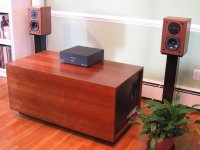 FriedHsetuplikemarketingdrawing.jpg91.9 KB · Views: 736
FriedHsetuplikemarketingdrawing.jpg91.9 KB · Views: 736 -
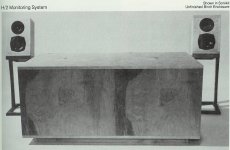 FriedH2fromSonikitbrochure1978.jpg103.5 KB · Views: 739
FriedH2fromSonikitbrochure1978.jpg103.5 KB · Views: 739 -
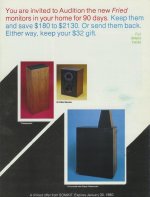 SONIKIT Brochure Front.jpg84.7 KB · Views: 883
SONIKIT Brochure Front.jpg84.7 KB · Views: 883
Last edited:
Drivers used in the Fried H2, B2 and C1 Monitor/Satellite Speakers
The Model H/2 used a Dalesford 5" bextere cone mid-woofer (model D30/110) very similar to the KEF B-110 it replaced in the original Model B. The tweeter was a horn loaded soft dome unit by Dynaudio, Model D-28H (so named for the 28mm diameter and the "H" indicates the addition of a Horn/Waveguide). This tweeter has exceptional power handling capability, and allowed Fried to use a first order high pass crossover on the tweeter. It also had a sticky coating, so dust on the dome shows up in the photos.
First Image: The Dalesford D30/110 mid-woofers used in the B/2. Note that Fried applied a label to the rear of the magnet, but left the Dalesford model number on the drivers.
There were several versions of the Dalesford driver used in the first model C and O before Dalesford went belly up.
Fried used a thinner bextrene cone that was more heavily damped with the Plastiflex damping material. This achieved a higher sensitivity by the reduction in cone mass. These also had a larger magnet structure and longer pole piece than the stock versions.
Second Image: Dynaudio D-28H tweeters used in B/2 and C/1. Note again the Fried label on the rear of the driver.
Third Image: Spec sheet for the Dynaudio D-28 tweeter. Note the almost completely flat impedance curve, as the resonance is damped with ferrofluid.
The Dynaudio D-28 is a tweeter I know well.
This is one of the very first hornloaded dome tweeters and - like all Dynaudio products - its construction is top notch, as is the performance. Many of these tweeters are still in operation today and even though its 40 !!! years old, it will easily outperform many contemporary tweeters. Contrary to most Dynaudio woofers, this little gem has a remarkably high sensitivity.
The Model H/2 used a Dalesford 5" bextere cone mid-woofer (model D30/110) very similar to the KEF B-110 it replaced in the original Model B. The tweeter was a horn loaded soft dome unit by Dynaudio, Model D-28H (so named for the 28mm diameter and the "H" indicates the addition of a Horn/Waveguide). This tweeter has exceptional power handling capability, and allowed Fried to use a first order high pass crossover on the tweeter. It also had a sticky coating, so dust on the dome shows up in the photos.
First Image: The Dalesford D30/110 mid-woofers used in the B/2. Note that Fried applied a label to the rear of the magnet, but left the Dalesford model number on the drivers.
There were several versions of the Dalesford driver used in the first model C and O before Dalesford went belly up.
Fried used a thinner bextrene cone that was more heavily damped with the Plastiflex damping material. This achieved a higher sensitivity by the reduction in cone mass. These also had a larger magnet structure and longer pole piece than the stock versions.
Second Image: Dynaudio D-28H tweeters used in B/2 and C/1. Note again the Fried label on the rear of the driver.
Third Image: Spec sheet for the Dynaudio D-28 tweeter. Note the almost completely flat impedance curve, as the resonance is damped with ferrofluid.
The Dynaudio D-28 is a tweeter I know well.
This is one of the very first hornloaded dome tweeters and - like all Dynaudio products - its construction is top notch, as is the performance. Many of these tweeters are still in operation today and even though its 40 !!! years old, it will easily outperform many contemporary tweeters. Contrary to most Dynaudio woofers, this little gem has a remarkably high sensitivity.
Attachments
Last edited:

Here's a new one of Troels's that I have just come across: the MUN-17-3W, which he classifies as one of his "Classic 3-Ways", but goes well beyond even the Audio Technology version. It is an all-ScanSpeak design, with an 11" woofer in a closed box (unusual for Troels), a 6" midrange and a beryllium tweeter. As with several of his larger speaker projects, the bass is driven by an integral Hypex module to take the strain off the MT amplifier.
If I weren't still very happy with my SEAS three-ways (and had a better listening room in a detached house, rather than the awkwardly shaped living room in our suburban terrace), I would be very tempted to start saving for this one...
Alex
Last edited:
Bud Fried vs. Crossovers
Quote from Audioholics President Gene DellaSala with a reply from Dennis Murphy (edited):
"Oh Boy Bud Fried was quite the myth perpetuator. I recall on a phone call with him, he once told me metal drivers are junk and any speaker that doesn't use a first order series crossover and a transmission line enclosure is also junk. He always claimed his speakers measured like a resistor but never furnished the measurements to prove it. He was an interesting character to say the least and he certainly didn't keep his opinions to himself
We did a little study of series vs parallel crossovers (1st order in accordance to Fried Gospel). Ironically you can make the response of either network look identical.
Bud was a big proponent of time-coherent speakers and mocked any designs that used higher order filter response networks. I recall him writing a letter to Stereophile to admit that people prefer the sound of shallow slope time coherent speakers over high order filter network alternatives.
Series crossovers put high demands on inductor DCR which in turn dumps a lot of low frequency energy into the tweeter. My understanding was that Fried used Quasi-Second Order Series crossovers -which would rolloff more rapidly in the first octave and then level out to first order below that. IMO, many of his theories were actually backwards. For better power handling and less strain (especially on the tweeter), smoother and more accurate in-room tonal balance, you want slow roll off through the xover region and then faster roll off out of band."
"The series approach definitely had a pretty steep learning curve, and you have to do it pretty much by hand and instinct. The optimization programs on crossover design software tends to go off into sonic space because there's so much interaction in driver response when you change one component. The current conventional wisdom is that series crossover have no inherent advantage over parallel circuits--both should perform essentially the same if the same transfer function is achieved."
Series crossovers have been around for ages. Gilbert Briggs was quite keen on these. In his book on loudspeakers, he gives series and parallel versions for all crossovers.
Bud also stated he learned about using series resonance crossover circuits from the engineers in Denmark.
Since he was good friends with Saul Marantz who had also used series crossovers in some of his early speaker designs. I think he had received some valuable insight from him about this type of design.
Irving M. "Bud" Fried wrote articles about his thoughts on loudspeakers which are available here
and here
And for those who like to learn more about the Sonitkit speakers, you'll find it here
Quote from Audioholics President Gene DellaSala with a reply from Dennis Murphy (edited):
"Oh Boy Bud Fried was quite the myth perpetuator. I recall on a phone call with him, he once told me metal drivers are junk and any speaker that doesn't use a first order series crossover and a transmission line enclosure is also junk. He always claimed his speakers measured like a resistor but never furnished the measurements to prove it. He was an interesting character to say the least and he certainly didn't keep his opinions to himself
We did a little study of series vs parallel crossovers (1st order in accordance to Fried Gospel). Ironically you can make the response of either network look identical.
Bud was a big proponent of time-coherent speakers and mocked any designs that used higher order filter response networks. I recall him writing a letter to Stereophile to admit that people prefer the sound of shallow slope time coherent speakers over high order filter network alternatives.
Series crossovers put high demands on inductor DCR which in turn dumps a lot of low frequency energy into the tweeter. My understanding was that Fried used Quasi-Second Order Series crossovers -which would rolloff more rapidly in the first octave and then level out to first order below that. IMO, many of his theories were actually backwards. For better power handling and less strain (especially on the tweeter), smoother and more accurate in-room tonal balance, you want slow roll off through the xover region and then faster roll off out of band."
"The series approach definitely had a pretty steep learning curve, and you have to do it pretty much by hand and instinct. The optimization programs on crossover design software tends to go off into sonic space because there's so much interaction in driver response when you change one component. The current conventional wisdom is that series crossover have no inherent advantage over parallel circuits--both should perform essentially the same if the same transfer function is achieved."
Series crossovers have been around for ages. Gilbert Briggs was quite keen on these. In his book on loudspeakers, he gives series and parallel versions for all crossovers.
Bud also stated he learned about using series resonance crossover circuits from the engineers in Denmark.
Since he was good friends with Saul Marantz who had also used series crossovers in some of his early speaker designs. I think he had received some valuable insight from him about this type of design.
Irving M. "Bud" Fried wrote articles about his thoughts on loudspeakers which are available here
and here
And for those who like to learn more about the Sonitkit speakers, you'll find it here
Attachments
Last edited:
I have some files on Bud Fried too... 
He liked transmission lines.
He liked first order filters.
Not averse to sloped baffle or time alignment as we call it now.
He used wide bandwidth drivers and tweeters that could handle some excursion. Like the 5" Dalesford bextrene and the Dynaudio D28 tweeter.
He was actually fairly flexible in using series or parallel crossovers.
Series filters were used by Richard Allen and Tandberg quite a lot, IIRC.
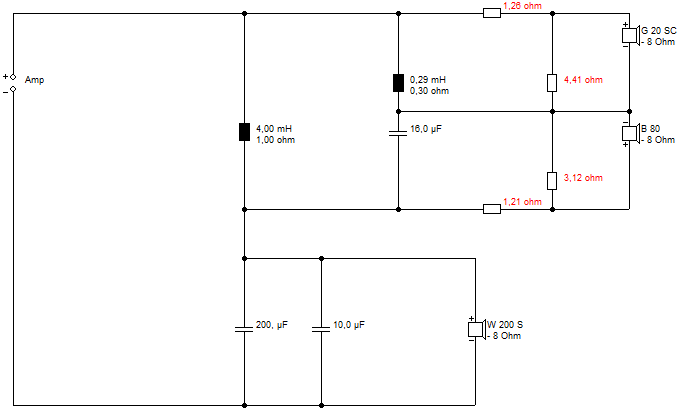
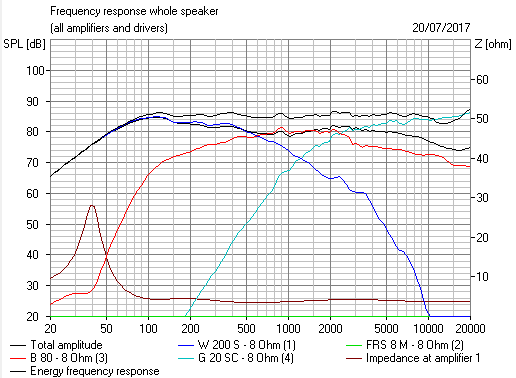
Potentially you can get very flat impedance with them, but this can be done with parallel too. My current interest, as it goes.
These ideas are all part of the pot-pourri of speaker building, IMO. Obviously the shallower the filter, the less you hear it and its resonance. But you then hear more distortion.
Some Bud Fried stuff below, from the "system7" files. The truth is out there!
He liked transmission lines.
He liked first order filters.
Not averse to sloped baffle or time alignment as we call it now.
He used wide bandwidth drivers and tweeters that could handle some excursion. Like the 5" Dalesford bextrene and the Dynaudio D28 tweeter.
He was actually fairly flexible in using series or parallel crossovers.
Series filters were used by Richard Allen and Tandberg quite a lot, IIRC.
Potentially you can get very flat impedance with them, but this can be done with parallel too. My current interest, as it goes.
These ideas are all part of the pot-pourri of speaker building, IMO. Obviously the shallower the filter, the less you hear it and its resonance. But you then hear more distortion.
Some Bud Fried stuff below, from the "system7" files. The truth is out there!
Attachments
-
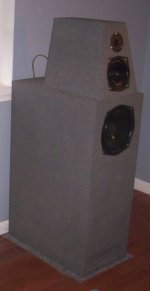 Bud Fried Speaker.JPG23.1 KB · Views: 188
Bud Fried Speaker.JPG23.1 KB · Views: 188 -
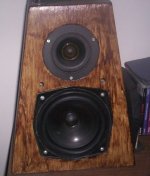 Fried C Satellite... I think....JPG42.3 KB · Views: 624
Fried C Satellite... I think....JPG42.3 KB · Views: 624 -
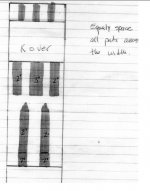 Damping Fried Transmission Line.JPG29.1 KB · Views: 167
Damping Fried Transmission Line.JPG29.1 KB · Views: 167 -
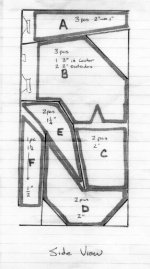 Fried Cabinet Cheese-wedge and Mid Transmission lne bass.JPG34.9 KB · Views: 188
Fried Cabinet Cheese-wedge and Mid Transmission lne bass.JPG34.9 KB · Views: 188 -
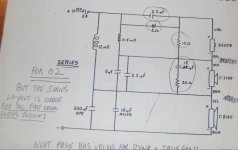 Fried O2 series filter.JPG52.6 KB · Views: 221
Fried O2 series filter.JPG52.6 KB · Views: 221 -
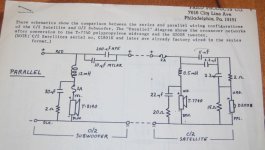 Fried C2 Satellite.JPG57.6 KB · Views: 268
Fried C2 Satellite.JPG57.6 KB · Views: 268 -
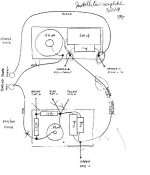 Fried KEF B200 Big Box.JPG39.9 KB · Views: 163
Fried KEF B200 Big Box.JPG39.9 KB · Views: 163 -
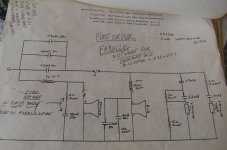 Fried Super Monitor.JPG70.2 KB · Views: 188
Fried Super Monitor.JPG70.2 KB · Views: 188
Thanks Steve, for the backup on Bud 
I couldn't find any proof for this, but it is my guess that Dave Wilson got at least some inspiration from the C-monitors in designing the WATT's.
He would have done better with the Dynaudio D-28 instead of the screaming Focal and the roundovers at the baffle edges, instead of his ugly felt pads.
I couldn't find any proof for this, but it is my guess that Dave Wilson got at least some inspiration from the C-monitors in designing the WATT's.
He would have done better with the Dynaudio D-28 instead of the screaming Focal and the roundovers at the baffle edges, instead of his ugly felt pads.
Last edited:
Is this a classic monitor? I'm not sure. The Monitor Audio MA7. Not bad for £10 anyway in my local charity shop. And it all works! Comes as a matched pair too, so you can have both tweeters on the inside. 
It's actually a very nice speaker with good bass from the 12L reflex box. 5" coated paper fibre bass with 105mm cone. 19mm mylar tweeter, quite like a KEF T27 or Coles 4001K. The tube is 4" x 1 3/8". 6 element filter. 3 coils, 3 capacitors. I'm pretty sure it's a BW3.
It does shriek a bit on trumpets. Definitely something peaky at 3kHz. But very nice and lively sound and great vocals. I think I could tidy it up a bit, but that's for another day.
One bass has a surround that hasn't been glued on quite right, so there is a kink in it. But not broken enough to fix.
It's this idea, isn't it. Vifa PL14WJ-
The simulation allows for the ESR of the Elcap 50V NP capacitors and the unusual 8.5R DC of the tweeter. 6 ohm bass DC. The dotted line on the FR shows the worse response with MKP capacitors. They come with attractive black cloth grilles which given the bright balance work well.
It's actually a very nice speaker with good bass from the 12L reflex box. 5" coated paper fibre bass with 105mm cone. 19mm mylar tweeter, quite like a KEF T27 or Coles 4001K. The tube is 4" x 1 3/8". 6 element filter. 3 coils, 3 capacitors. I'm pretty sure it's a BW3.
It does shriek a bit on trumpets. Definitely something peaky at 3kHz. But very nice and lively sound and great vocals. I think I could tidy it up a bit, but that's for another day.
One bass has a surround that hasn't been glued on quite right, so there is a kink in it. But not broken enough to fix.
It's this idea, isn't it. Vifa PL14WJ-
The simulation allows for the ESR of the Elcap 50V NP capacitors and the unusual 8.5R DC of the tweeter. 6 ohm bass DC. The dotted line on the FR shows the worse response with MKP capacitors. They come with attractive black cloth grilles which given the bright balance work well.
Attachments
-
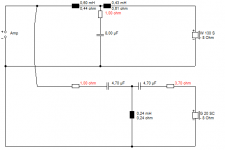 Monitor Audio MA7 circuit used for simulation.PNG7.2 KB · Views: 638
Monitor Audio MA7 circuit used for simulation.PNG7.2 KB · Views: 638 -
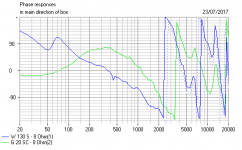 Monitor Audio Phase simulation.PNG21.7 KB · Views: 1,530
Monitor Audio Phase simulation.PNG21.7 KB · Views: 1,530 -
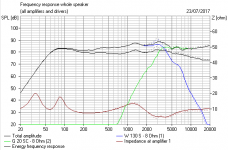 Monitor Audio MA7 FR Simulation.PNG20.2 KB · Views: 592
Monitor Audio MA7 FR Simulation.PNG20.2 KB · Views: 592 -
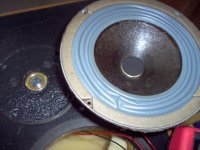 Monitor Audio MA7 Drivers.jpg80 KB · Views: 122
Monitor Audio MA7 Drivers.jpg80 KB · Views: 122 -
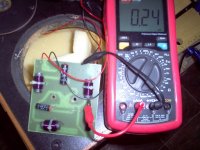 Monitor Audio MA7 Coil test.jpg90.1 KB · Views: 143
Monitor Audio MA7 Coil test.jpg90.1 KB · Views: 143 -
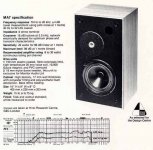 Monitor Audio MA7.JPG61.9 KB · Views: 963
Monitor Audio MA7.JPG61.9 KB · Views: 963 -
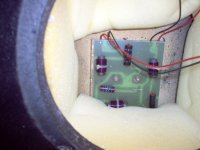 Monitor Audio MA7 Construction.jpg64.8 KB · Views: 2,771
Monitor Audio MA7 Construction.jpg64.8 KB · Views: 2,771
Last edited:
- Home
- Loudspeakers
- Multi-Way
- Classic monitor designs?

